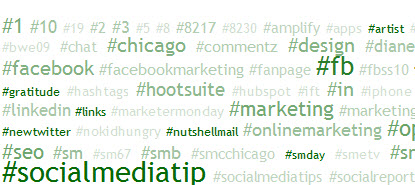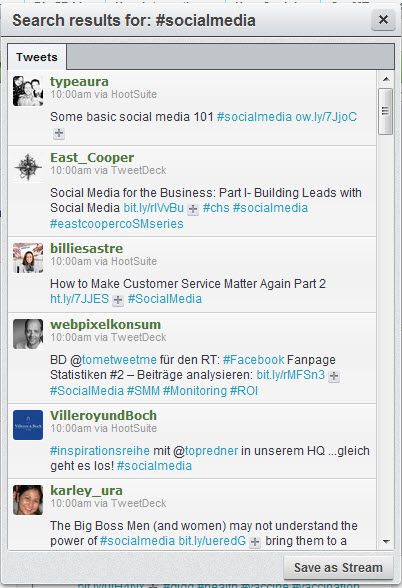#hashtag
As anyone who uses Twitter knows, the ‘#’ symbol, called a hashtag, is used to mark keywords or topics in a Tweet. Interestingly enough, it was created organically by Twitter users as a way to categorize messages. Hashtags are simply a way to “tag” your tweet with subject matter to make it easy to be found. Anyone can create a hashtag simply by placing the ‘#’ sign in front of a word.
Businesses and brands can effectively use hashtags to increase exposure, find relevant conversations to join or retweet and ultimately, grow their Twitter accounts and business. Following are a few ideas to get you started with leveraging the power of the Twitter hashtag for business.
What’s on Your Hashtag List?
It’s a good business practice to make a list of commonly used hashtags around your business or brand that you can pull from when creating your tweets. When researching which hashtag(s) to use in your business tweets, check out Twitter Search (simply type in the hashtag into the search bar), What the Trend, Twubs, Tagal.us or Hashtags.org. All of these resources are slightly different and all offer some unique insight into hashtag usage.
Social Intelligence
You can also easily view which hashtags your business competitors are using with TweetStats. Along with other Twitter data, you can view the top five most commonly used hashtags of any Twitter user and even create a hashtag cloud of any twitter user. Tweet Grader will also provide a hashtag cloud on any twitter user and provide other top level Twitter stats.
Hashtag your Event
Promote your company news or events with a custom hashtag to make it easy for people to find and follow your information. If you are attending a business event, tweet from it using the conference hashtag to make your tweets more visible and enhance your reputation as an expert in your field. If your business is hosting or speaking at an event, create a conference hashtag around that event and publicize it on the event email, invitation, in blog posts, through Facebook and Twitter posts, on LinkedIn and at the beginning of the event itself. Attendees and speakers can tweet from the actual event using the event hashtag creating a virtual event for others to follow.
You can archive your tweets for future reference for yourself, colleagues and potential customers using Twapper Keeper.
For more detailed information on using hashtags for events, check out 6 Tips to Maximinze Twitter Event Hashtags.
Streaming Hashtags
If you use a social media dashboard such as HootSuite (our preference at Harp Social), you can easily create real-time streams of any tweet around a certain hashtag. For example, someone in the widget business can pull in real time tweet stream of any tweet that is marked with the hashtag, #widget. This is extremely useful in finding content to interact with, tweet or retweet and to find content to read for education or enjoyment. Pulling in a hashtag stream provides a greater variety of content than pulling in a stream based on a list.
You can also receive a daily email digest of any specific hashtags using Twilert. This is a great way to stay on top of what’s being tweeted about in your industry.
Hashtag Best Practices:
There are a few basic Best Practices to keep in mind when tweeting with hashtags:
- Only use hashtags that are relevant to your tweet (though the specific hashtag doesn’t necessarily need to be contained within your tweet)
- Don’t use any more than three hashtags per tweet
- Hashtags can appear anywhere in the tweet
- There is no need to repeat a word in a tweet just to make it a hashtag
- When combining two words to create a tweet, it’s a good idea (but not necessary) to use initial caps of each word, e.g. #SocialMedia
- Short hashtags are better
What are some ways you’ve found hashtags useful for business? Share with us here.




